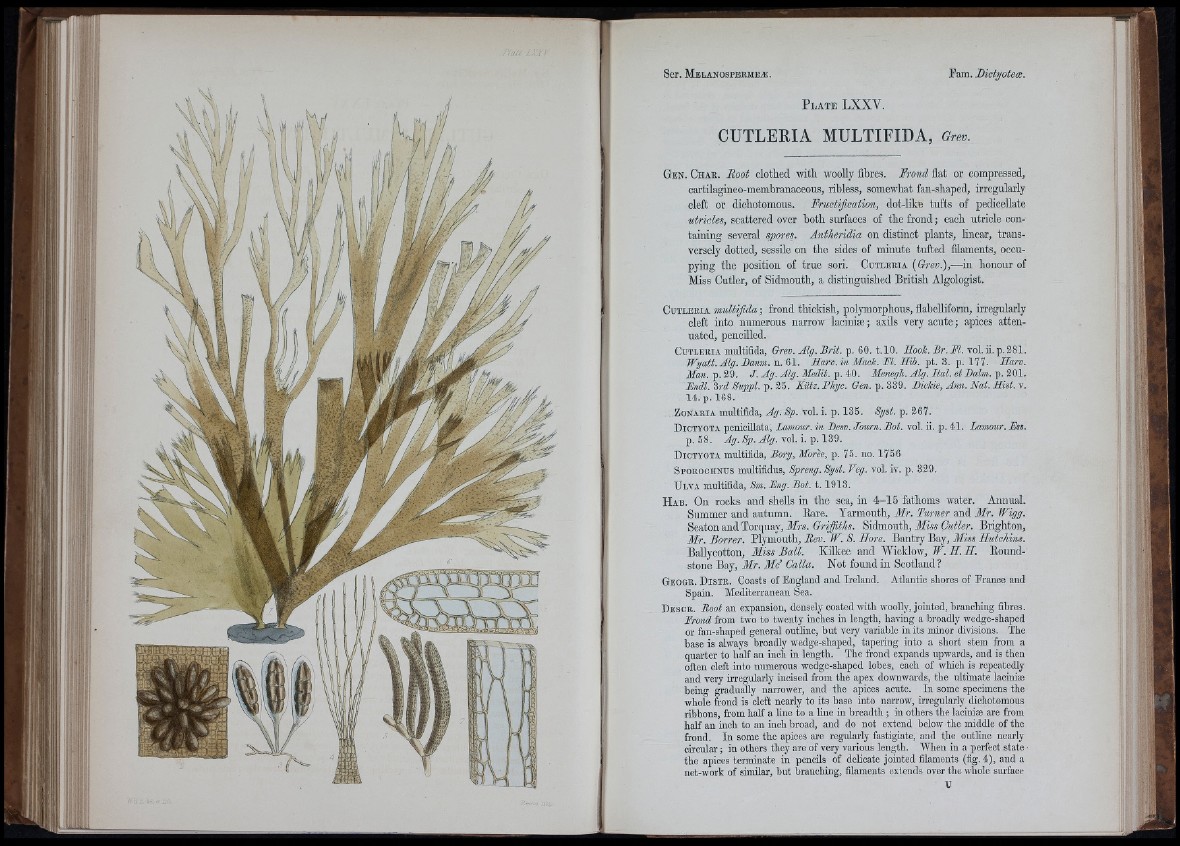
ji ''i
iti;,
il II
'Tl
P l a t e LXXV.
CUTLERIA MULTIFIDA, Grev.
G e n . C h a b . Root clothed with woolly fibres. Iro n d flat or compressed,
cartilagineo-membranaceous, ribless, somewhat fan-shaped, irregularly
cleft or dichotomous. Fructification, dot-like tufts of pedicellate
utricles, scattered over both surfaces of the frond; each utricle containing
several spores. Antheridia on distinct plants, Hnear, transversely
dotted, sessile on the sides of minute tufted filaments, occupying
the position of true sori. C u t l b k i a [Grev.),—in honour of
Miss Cutler, of Sidmouth, a distinguished British Algologist.
CuTLEBiA multifida ; frond thickish, polymorphous, flabelhform, irregularly
cleft into numerous narrow laciniæ ; axils very acute ; apices attenuated,
pencilled.
CuTLEBiA multifida, Grev. Alg. Brit. p. 60. t.lO. Hoolc. B r .M . vol.ii.p.381.
Wyatt. Alg. Banm. n. 61. Harv. in Mack. M. Hib. pt. 3. p. 177. Harv.
Man. p. 29. J. Ag. Alg. Medit. p. 40. Menegh. Alg. Ital. et Balm. p. 201.
Endl. 3rd Suppl. p. 25. Kiitz. Phyc. Gen. p. 339. Bickie, Ann. Nat. Hist. v.
14. p. 168.
ZoNABiA m u ltifid a , Ag. Sp. vol. i. p. 135. Syst. p. 267.
D i c t y o t a p e n ic illa ta , Lamour. in Besv. Journ. Bot. vol. ii. p . 4 1 . Lamour. E ss.
p . 5 8 . A g . S p .A l g . v G i . \ . - g . \ 3 9 .
D io ty o ta m u ltifid a , Bory, Moree, p . 75. n o . 1756
Spo e o o h n u s m u ltifid u s, Sp-eng.Syst. Veg. v o l.iv . p . 3 2 9 .
U l v a m u ltifid a , Sm. Eng. Bot. 1 . 1 9 1 3 .
H a b , On rocks and shells in the sea, in 4 -1 5 fathoms water. Annual.
Summer and autumn. Eare. Yarmouth, Mr. Turner and Mr. Wigg.
Seaton and Torquay, Mrs. Griffiths. Sidmouth, Miss Cutler. Brighton,
Mr. Borrer. Plymouth, Rev. W. 8. Bore. Bantry Bay, Miss Hutchins.
Ballycotton, Miss Ball. Killcee and Wicklow, W. H. H. Eoundstone
Bay, Mr. M d Calla. Not found in Scotland?
G e o g e . D i s t e . Coasts of England and Ireland. Atlantic shores of France and
Spain. Mediterranean Sea.
D e s c e . Root an expansion, densely coated with woolly, jointed, branching fibres.
Erond from two to twenty inches in length, having a broadly wedge-shaped
or fan-shaped general outline, but very variable iii its minor divisions. The
base is always broadly n'edge-shaped, tapering into a short stem from a
quarter to half an inch in length. The frond expands upwards, and is then
often cleft into numerous wedge-shaped lobes, each of which is repeatedly
and very irregularly incised from the apex downwards, the ultimate laciniæ
being gradually naiTOwer, and the apices acute. In some specimens the
whole frond is cleft nearly to its base into narrow, irregularly dichotomous
ribbons, from half a line to a line in breadth ; in others the laciniæ are from
half an inch to an inch broad, and do not extend below the middle of the
frond. In some the apices are regularly fastigiate, and the outline nearly
circular ; in others they are of very various length. When in a perfect state •
the apices terminate in pencils of delicate jointed filaments (fig. 4), and a
net-work of similar, but branching, filaments extends over tlie whole surface
U
t i “?!)